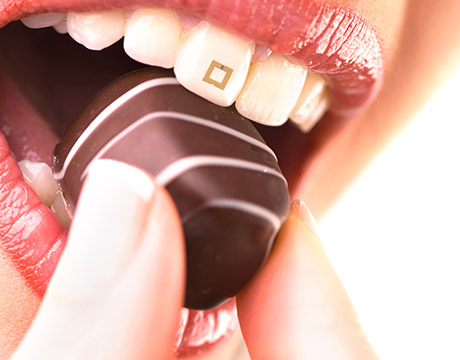Mini Sensor Detects and Measures What We Eat, Part 2
Mini Sensor Detects and Measures What We Eat, Part 2


Researchers have developed a miniaturized sensor that can transmit biodata. Image: Tufts University
Part 1 of “Mini Sensor Detects and Measures What We Eat” introduced you to the work of Fiorenzo Omenetto. Part 2 explores how he and his team built the device and the changes future versions of it will undergo.
These are not the first devices developed to measure food intake, but others have had various limitations: intricate microphones, accelerometers, and electromyography to monitor chewing movements; awkward mouth guards, bulky wiring, and systems requiring frequent sensor replacement. Using ambient radio waves prevalent in modern day environments eliminates the need for a power supply.
In theory we can modify the bioresponsive layer in these sensors to target other chemicals; we are really limited only by our creativity. Dean Fiorenzo Omenetto, Tufts University
The work on this device evolved out of work on implantable devices Omenetto’s lab has been working on for years. “This was one of the many evolutions, platforms, and materials we designed,” Omenetto says. “It’s been a long journey.”The initial work on this device used a single larger layer that operated on a single frequency. “We progressively went smaller and to a multi-layered device because of functionality,” he explains.
For You: Engineers Help Fight Opioid Addiction
The biggest challenges have been those that are “endemic to the material formats and interfaces,” he says. “It’s never easy to interface something that has to operate in a wet environment. So there were a lot of challenges in designing the material, assembling the material, and having active layers of the materials. It’s always about material format and how to make materials versatile and useful.”
While pleased with reaching the milestone described in the article, he still considers the sensing fairly primitive and requiring more work. The format opens the door to making the sensors more sophisticated; to build more sensitivity and specificity. “This is just one step along the way of making something that can be of physiological utility,” he says.
When asked when it will be ready to go, he responds, “What for? To measure what? If you want the sensor to communicate and store every minute the exact number of calories you’ve consumed, it’s going to take a long while. If you want a coarse measurement of whether you have high pH or low pH in the mouth, then you need to find a partner [to commercialize it]. That can happen fairly quickly. These things depend on so many intangibles and depend on what you want to do with it.”
From a scientific standpoint, the goal is to build greater sensitivity and specificity for certain markers of health that can be detected in the oral cavity. To do so, the team plans to continue to refine the material format and to work with variables that can provide physiological indicators for answering certain medical questions.
"In theory we can modify the bioresponsive layer in these sensors to target other chemicals; we are really limited only by our creativity," Omenetto says. "We have extended common RFID technology to a sensor package that can dynamically read and transmit information on its environment, whether affixed to a tooth, to skin, or any other surface."
Nancy Giges is an independent writer.
Read More:
Hot Opportunities in Microfluidics for MEs
Engineers Contain Cancer Cells
Researchers 3D Print on Skin for Breakthrough Applications



